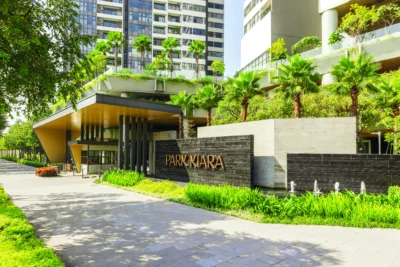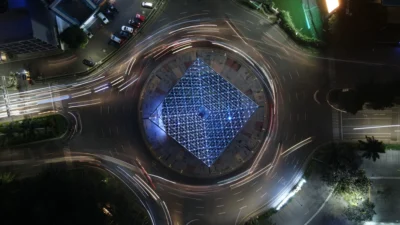Better together: making the most of mixed-use developments
The walls of living and work spaces are coming down throughout Southeast Asia
From Singapore to Ho Chi Minh City, Southeast Asian developers are seeing the benefits of mingling business with pleasure. Self-contained communities that offer residences, retail, offices, and green spaces are emerging as the new development paradigm across a region where old ideas of city zoning are being eroded by vertical mixed-use mega-projects.
Singapore’s newly opened Marina One residential and office development has added a tropical, green heart to the CBD in the form of a 65,000-square-foot garden designed in collaboration between Ingenhoven Architects and landscape specialists ICN Design.
Jakarta’s District 8, a development of 11 towers across 4.8 hectares of the Sudirman Central Business District, has also reached completion. Developed by the Agung Sedayu Group, it brings residences and a public park right into the heart of South Jakarta’s financial zone.
In Bangkok, TCC Group’s One Bangkok (in partnership with Golden Land and Frasers Property Limited) is a USD3.5 billion development that covers an area one third the size of the adjacent Lumphini Park and encompasses living and work space for 60,000 people, including residential buildings, office towers, retail zones, and publicly accessible parks and green spaces.
“Vertical communities often deal with the high density mandated for many Asian city centres,” says Ping Jiang, the design principal at EID architecture. His firm designed the 320-metre-tall OCT XI’AN International Centre (OXIC) in Xi’an, China, where parks, piazza-style common areas, and even terrace streets are positioned over multiple storeys of two skyscrapers.
In contrast to sprawling development, Jiang points out, “vertical communities create synergy between different uses and foster dynamic neighbourhoods. By integrating business, leisure, retail, and residential spaces, the design of a vertical community is strategically organised to create a vibrant, permeable urban destination to live, work, and visit.”
Analysts at JLL real-estate services predict vertical living solutions will dominate the Asian market. “As cities become more developed, and densities become higher, it makes sense to build more mixed-use developments,” says Regina Lim, head of capital markets research, Southeast Asia.
“Mixed-use developments bring together complementary uses,” she continues. “Retail shops benefit from the natural catchment of offices or hotels or apartments while the residents and workers enjoy the convenience. As maintenance management schemes become more sophisticated, they allow effective property management of these integrated projects. Apartments with these amenities sell well.”
But not all trends in Asian mixed-use are vertical. Throughout the Philippines, developers continue to favour township-style projects, for which huge land footprints provide fertile ground to design integrated communities from the ground up.
Megaworld Corporation has long been at the forefront of building from scratch new towns whose components stretch from serviced condominiums and rows of townhouses to malls, leisure facilities, and shopping districts.
This year alone, Megaworld has announced new residential and commercial developments for its townships in Manila, Pampanga, Pasig City, and Bacolod City, while also rolling out a “smart township” initiative to future-proof its existing townships.
Starting with Davao Park District, the “iTownship” programme will see the 11-hectare development fitted with fibre optic infrastructure, bike lanes and rental systems, LED-powered lighting and signage, solar-powered street lamps, and vertical open spaces and gardens.
While townships have traditionally been confined to once rural areas, UAA Kinming Group’s New Manila Bay – City of Pearl is being developed on a huge tract of reclaimed land along Manila’s shoreline. Projected to open in 2024, City of Pearl broke ground in August 2017 and, when completed, will take up 407 hectares of reclaimed land and connect directly to Roxas Boulevard, a major thoroughfare.
For comparison, Thailand’s under-construction One Bangkok mixed-use project—itself a huge project for a capital city centre—covers just 18 hectares. “There are many townships in Asia, but those townships are in the middle of nowhere,” says Nicholas Ho, deputy managing director of Ho & Partners Architects, the Hong Kong-based lead designer of the project. “This township is extremely prime in terms of its location—it’s right smack in the middle of town, with 360-degree views.”
Ho reveals that retail, in the form of a three-kilometre riverfront shopping strip, is not “just a mall” but engages with the central park and the riverside, “so that it becomes a thematic integrated entertainment complex.”
Similarly in Vietnam, Ho Chi Minh City’s Thu Thiem New Urban Area will cover a vast 657-hectare site across the Saigon River from the central District 1. Touted as the capital’s new financial zone, it will not only encompass office towers for some 217,000 employees, but also enough residential units for a population of 145,000.
It’s not only in urban areas, however, where ambitious mixed-use projects are breaking the mould. On the tree-lined shores of Phuket’s Kamala Beach, the USD67.5 million luxury MontAzure development comprises hotel-managed condos, a lifestyle mall, a 200-room InterContinental Hotel, and Cafe del Mar, which is already part of the development’s unique beachfront attractions.
WE ARE SPOILED BY THE COMPACTNESS OF URBANISATION, A PRECURSOR OF MIXED-USE DESIGN. URBANISATION HAS HAPPENED ON A GLOBAL SCALE AND IT’S ALL BECAUSE WE CRAVE CONNECTIVITY
“Developers are realising that if they build a core concept, it adds value to the project, rather than simply selling parcels of land,” says Martin Palleros, founder and director of Tierra Design and the architect behind The Residences at MontAzure. “It’s all about what you can offer the community, and not just in terms of the property components,” he adds.
Nicholas Ho believes that driving Asia’s demand for such integrated developments is an urge to feel connected. “In Asian society, people crave for connectivity a lot more than the rest of the world,” he explains. “We are spoiled by the compactness of urbanisation, a precursor of mixed-use design. Urbanisation has happened on a global scale and it’s all because we crave connectivity.”
Successful mixed-use schemes have the capacity to create diverse, vibrant neighbourhoods in which people can live, work, and socialize. They bring round-the-clock life to central business districts. They provide private land parcels with pedestrian-friendly solutions and interlink disparate downtown neighbourhoods.
Ho predicts this integrated, community-driven approach to development will gradually become the new normal. “The future of mixed–use is going to shift the existing paradigm,” he says. “We will gradually move from the two extremes of urbanisation, urban and suburban, towards one. The walls of living and work spaces are coming down.”
This article originally appeared in Issue No. 151 of PropertyGuru Property Report Magazine
Recommended
Park Kiara in Hanoi raises the bar for sustainable urban living
Park Kiara in Hanoi is a repudiation of low-density, car-dependent suburban sprawl
6 reasons Bekasi is rising as Greater Jakarta’s next hotspot
One of Greater Jakarta’s rising stars is prospering, thanks to ample recreation and a contingent of desirable housing projects
6 developments driving Asia’s green real estate shift
Developers are being incentivised to push a green agenda into daring new realms
The Philippines’ LIMA Estate drives sustainable industrial growth
LIMA Estate models a citywide vision that uplifts workers while appealing to climate-conscious employers








